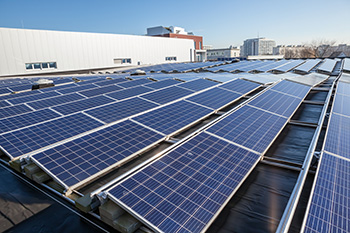Roof-mounted solar panels: Risks vs. benefits

There has been a recent surge in the adoption of roof-mounted photovoltaic PV solar panels due to the growing focus on renewable energy. Benefits include a reduced carbon footprint, cheaper energy bills and additional income when selling the electricity back to the grid. However, there are increased property and liability risks to consider.
Risk Considerations
In areas prone to high winds or hurricanes, properly securing PV arrays is crucial.
- Uplift could cause panels to detach from the building, potentially damaging the roof, other property or causing injuries.
- Slippage, or movement of the panels can damage your roof covering, which could lead to water intrusion into the building.
- Mechanically fastened panels are preferable over ballasted systems, as ballasts can shift over time. Ballasts require more maintenance and potential roof covering damage, roof drain blockage or loose wiring connections that may lead to arcing or fires.
Structural Considerations
The additional weight of the PV array must be factored into the building’s structural integrity.
- Structural upgrades or additional engineering may be necessary to provide adequate support.
- Consult with a structural engineer to assess whether your building can support a PV system’s weight.
It is important to collaborate with a roofing contractor who understands PV systems. Not all roofing contractors are solar experts, and vice versa. You should work with a licensed roofing contractor to inspect your roof and ensure it is compatible with the type of PV system you plan to install.
Most PV systems have a lifespan of 20 years or more. Ensure that your roof’s expected lifespan aligns with the PV array’s predicted life span.
Emergency Preparedness and Maintenance
The electricity generated by PV systems introduces additional exposures, especially during emergency situations and for first responders.
- Roof-mounted systems should be reported to the fire department so they can update their pre-planning documentation.
- Install and clearly identify emergency disconnects and rapid cut-offs to enhance safety.
- Implement regular preventative maintenance and inspection schedules to identify and address potential fire or injury risks.
- While some maintenance tasks can be handled by trained in-house staff, complex procedures are best left to qualified contractors. See our resource on inspections of PV arrays for more information.
Ongoing Assessments and Compliance
- For arrays that were installed several years ago, conduct regular assessments to ensure compliance with newer guidelines.
- Given the growth and improvements in solar technology, new changes have developed to the National Electric Code to improve life safety.
- When installing a solar array, engage your Nationwide agent early in the planning process. Insurance carriers typically review the plans before providing coverage.
Businesses don’t have to navigate this hazard alone. Contact us online, schedule a virtual consultation, or contact your local Nationwide Loss Control Services representative for assistance.
